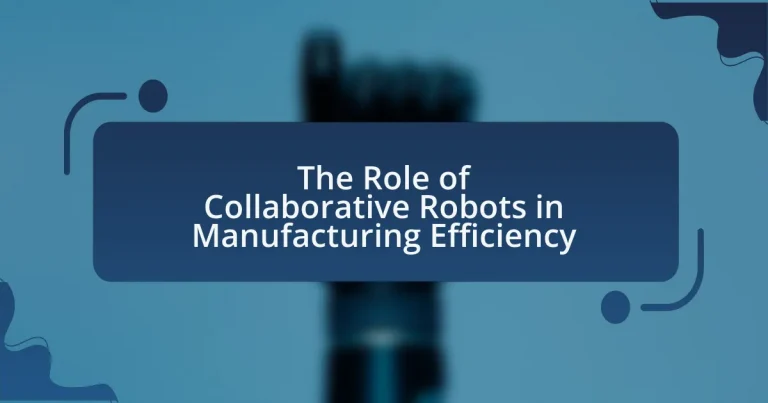Collaborative robots, or cobots, are advanced robotic systems designed to work alongside human operators in manufacturing environments, significantly enhancing efficiency and safety. Equipped with sensors and AI technology, cobots can perform various tasks such as assembly, packaging, and quality control, leading to productivity increases of up to 30%. Unlike traditional robots, cobots are engineered for safe interaction with humans, eliminating the need for safety cages and allowing for direct collaboration. This article explores the key features, benefits, and challenges of integrating collaborative robots into manufacturing processes, as well as future trends and best practices for successful implementation.

What are Collaborative Robots and Their Role in Manufacturing Efficiency?
Collaborative robots, or cobots, are robotic systems designed to work alongside human operators in a shared workspace, enhancing manufacturing efficiency. These robots are equipped with advanced sensors and AI technology, allowing them to perform tasks such as assembly, packaging, and quality control while ensuring safety and ease of use for human workers.
The role of collaborative robots in manufacturing efficiency is significant; they can operate continuously without fatigue, increase production rates, and reduce human error. For instance, a study by the International Federation of Robotics reported that the integration of cobots can lead to a productivity increase of up to 30% in various manufacturing processes. Additionally, cobots can be easily programmed and reconfigured for different tasks, providing flexibility that traditional industrial robots lack. This adaptability allows manufacturers to respond quickly to changing market demands, further enhancing operational efficiency.
How do Collaborative Robots differ from Traditional Robots?
Collaborative robots, or cobots, differ from traditional robots primarily in their design and intended interaction with human workers. Cobots are engineered to work alongside humans safely, featuring advanced sensors and safety mechanisms that allow them to operate in close proximity without the need for safety cages, unlike traditional robots which often require isolation due to their speed and strength. This design enables cobots to enhance manufacturing efficiency by facilitating direct human-robot collaboration, thereby increasing productivity and flexibility in workflows. According to a report by the International Federation of Robotics, the adoption of collaborative robots has been growing rapidly, with a 25% increase in installations from 2019 to 2020, highlighting their role in modern manufacturing environments.
What are the key features of Collaborative Robots?
Collaborative robots, or cobots, are designed to work alongside humans in a shared workspace, enhancing manufacturing efficiency. Key features include safety mechanisms such as force-limiting technology, which allows them to stop operating when they encounter resistance, ensuring worker safety. Additionally, cobots are user-friendly, often featuring intuitive programming interfaces that enable quick setup and operation without extensive technical knowledge. Their versatility allows them to perform a variety of tasks, from assembly to packaging, adapting easily to different workflows. Furthermore, cobots are typically lightweight and portable, facilitating easy relocation within a manufacturing environment. These features collectively contribute to increased productivity and flexibility in manufacturing processes.
Why are Collaborative Robots considered safer for human workers?
Collaborative robots, or cobots, are considered safer for human workers because they are designed to work alongside humans without the need for safety cages or barriers. This design allows for direct interaction and cooperation, significantly reducing the risk of accidents. Cobots are equipped with advanced sensors and safety features that enable them to detect human presence and adjust their speed or stop operation to prevent collisions. For instance, a study by the International Federation of Robotics indicates that the integration of cobots in manufacturing environments has led to a 30% reduction in workplace injuries. This data supports the assertion that collaborative robots enhance safety for human workers by minimizing hazards associated with traditional industrial robots.
What impact do Collaborative Robots have on Manufacturing Processes?
Collaborative robots significantly enhance manufacturing processes by improving efficiency, flexibility, and safety. These robots, designed to work alongside human operators, can perform repetitive tasks with precision, thereby increasing productivity. For instance, a study by the International Federation of Robotics reported that the integration of collaborative robots can lead to a productivity increase of up to 30% in assembly lines. Additionally, they reduce the risk of workplace injuries by taking over hazardous tasks, allowing human workers to focus on more complex and creative activities. This dual benefit of efficiency and safety underscores the transformative role of collaborative robots in modern manufacturing environments.
How do Collaborative Robots enhance productivity in manufacturing?
Collaborative robots enhance productivity in manufacturing by automating repetitive tasks and working alongside human operators. These robots can perform functions such as assembly, welding, and material handling with precision and speed, which reduces cycle times and increases output. For instance, a study by the International Federation of Robotics reported that the integration of collaborative robots can lead to a productivity increase of up to 30% in certain manufacturing processes. Additionally, their ability to operate safely in close proximity to humans allows for more flexible workflows and the optimization of labor resources, further contributing to overall efficiency in manufacturing environments.
What specific tasks can Collaborative Robots perform in manufacturing environments?
Collaborative robots, or cobots, can perform specific tasks in manufacturing environments such as assembly, welding, painting, packaging, and quality inspection. These robots are designed to work alongside human operators, enhancing productivity and safety. For instance, in assembly lines, cobots can handle repetitive tasks like screwing or placing components, which allows human workers to focus on more complex activities. According to a study by the International Federation of Robotics, the integration of cobots can increase productivity by up to 30% in manufacturing settings, demonstrating their effectiveness in improving operational efficiency.
What are the challenges of integrating Collaborative Robots into Manufacturing?
Integrating Collaborative Robots (Cobots) into manufacturing presents several challenges, including safety concerns, workforce acceptance, and technical compatibility. Safety concerns arise because Cobots must operate alongside human workers, necessitating rigorous safety protocols to prevent accidents. Workforce acceptance is critical, as employees may resist adopting new technologies due to fear of job displacement or lack of understanding of Cobots’ roles. Technical compatibility issues can occur when integrating Cobots with existing machinery and software systems, requiring significant investment in infrastructure and training. According to a report by the International Federation of Robotics, 30% of manufacturers cite integration difficulties as a major barrier to adopting Cobots, highlighting the importance of addressing these challenges for successful implementation.
What technical challenges do manufacturers face when implementing Collaborative Robots?
Manufacturers face several technical challenges when implementing Collaborative Robots, including integration with existing systems, safety concerns, and programming complexity. Integration issues arise as manufacturers must ensure that collaborative robots can seamlessly work alongside traditional machinery and software, which often requires significant modifications to existing workflows. Safety concerns are paramount, as collaborative robots must be designed to operate safely in close proximity to human workers, necessitating advanced sensors and safety protocols to prevent accidents. Additionally, programming these robots can be complex, as manufacturers need to develop user-friendly interfaces and training programs to enable workers to effectively program and operate the robots without extensive technical expertise. These challenges highlight the need for careful planning and investment in technology to successfully implement collaborative robots in manufacturing environments.
How can companies overcome resistance to adopting Collaborative Robots?
Companies can overcome resistance to adopting Collaborative Robots by implementing comprehensive training programs and demonstrating the robots’ benefits through pilot projects. Training equips employees with the necessary skills to work alongside robots, alleviating fears of job displacement and enhancing collaboration. Pilot projects allow companies to showcase the efficiency and productivity gains achieved with Collaborative Robots, providing tangible evidence of their value. For instance, a study by the International Federation of Robotics found that companies integrating Collaborative Robots reported a 30% increase in productivity within the first year of implementation. This data supports the effectiveness of targeted training and real-world demonstrations in reducing resistance and fostering acceptance among employees.
How do Collaborative Robots contribute to cost savings in Manufacturing?
Collaborative robots contribute to cost savings in manufacturing by enhancing productivity and reducing labor costs. These robots can work alongside human operators, performing repetitive tasks with high precision and speed, which leads to increased output and efficiency. For instance, a study by the International Federation of Robotics reported that the integration of collaborative robots can boost productivity by up to 30%. Additionally, collaborative robots require lower initial investment and maintenance costs compared to traditional industrial robots, making them a cost-effective solution for manufacturers. This combination of increased productivity and reduced operational costs directly translates to significant savings for manufacturing companies.
What are the long-term financial benefits of using Collaborative Robots?
The long-term financial benefits of using Collaborative Robots include reduced labor costs, increased productivity, and enhanced operational flexibility. Collaborative Robots, or cobots, can work alongside human workers, allowing companies to optimize labor allocation and reduce the need for extensive manual labor, which can lead to significant savings on wages and benefits.
Additionally, cobots can operate continuously without breaks, leading to higher output rates and shorter production cycles. For instance, a study by the International Federation of Robotics reported that companies implementing cobots experienced productivity increases of up to 30%. Furthermore, the adaptability of cobots allows manufacturers to quickly reconfigure production lines for different tasks, minimizing downtime and maximizing resource utilization.
These factors collectively contribute to a more efficient manufacturing process, ultimately resulting in improved profit margins and a stronger competitive position in the market.
How do Collaborative Robots reduce labor costs in manufacturing?
Collaborative robots reduce labor costs in manufacturing by automating repetitive tasks, which minimizes the need for human labor in those areas. These robots can work alongside human operators, enhancing productivity without the overhead costs associated with hiring additional staff. For instance, a study by the International Federation of Robotics found that the integration of collaborative robots can lead to a 30% increase in productivity, allowing companies to achieve more output with fewer labor hours. This efficiency not only lowers direct labor costs but also reduces training and management expenses associated with a larger workforce.
What are the future trends for Collaborative Robots in Manufacturing?
Future trends for collaborative robots in manufacturing include increased integration with artificial intelligence, enhanced safety features, and greater adaptability to various tasks. The integration of AI allows collaborative robots to learn from their environments and improve their performance over time, leading to more efficient operations. Enhanced safety features, such as advanced sensors and real-time monitoring, ensure safer interactions between robots and human workers, which is crucial as these robots become more prevalent in manufacturing settings. Additionally, the development of modular and flexible robotic systems enables manufacturers to easily reconfigure robots for different tasks, thereby increasing productivity and reducing downtime. According to a report by the International Federation of Robotics, the market for collaborative robots is expected to grow significantly, with a projected increase in shipments from 50,000 units in 2020 to over 400,000 units by 2025, highlighting the rising demand and importance of these technologies in the manufacturing sector.
How is technology evolving to improve Collaborative Robots?
Technology is evolving to improve collaborative robots through advancements in artificial intelligence, machine learning, and sensor technology. These innovations enable robots to better understand and adapt to their environments, enhancing their ability to work alongside human operators safely and efficiently. For instance, AI algorithms allow robots to learn from their interactions, improving their task performance over time. Additionally, enhanced sensors provide real-time data on their surroundings, facilitating more precise movements and reducing the risk of accidents. According to a report by the International Federation of Robotics, the integration of these technologies has led to a 30% increase in productivity in manufacturing settings that utilize collaborative robots.
What role will Collaborative Robots play in the future of smart manufacturing?
Collaborative robots will play a crucial role in the future of smart manufacturing by enhancing productivity and flexibility in production processes. These robots are designed to work alongside human operators, allowing for a seamless integration of automation and human skills. According to a report by the International Federation of Robotics, the adoption of collaborative robots is expected to grow significantly, with projections indicating that the market for these robots will reach $12 billion by 2025. This growth is driven by their ability to perform repetitive tasks, reduce workplace injuries, and increase operational efficiency, thereby transforming traditional manufacturing environments into more agile and responsive systems.
What best practices should manufacturers follow when implementing Collaborative Robots?
Manufacturers should prioritize safety, training, and integration when implementing Collaborative Robots (Cobots). Ensuring safety involves conducting thorough risk assessments and adhering to safety standards such as ISO 10218, which outlines safety requirements for industrial robots. Training employees on Cobot operation and maintenance is crucial, as studies show that well-trained staff can increase productivity by up to 30%. Additionally, seamless integration of Cobots into existing workflows enhances efficiency; for instance, a study by the International Federation of Robotics found that companies that effectively integrated Cobots reported a 20% increase in operational efficiency. These best practices collectively contribute to maximizing the benefits of Collaborative Robots in manufacturing environments.





